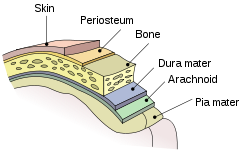- Meninges
-
Meninges 
Meninges of the CNS Gray's subject #193 872 Artery middle meningeal artery, meningeal branches of the ascending pharyngeal artery, accessory meningeal artery, branch of anterior ethmoidal artery, meningeal branches of vertebral artery Nerve middle meningeal nerve, nervus spinosus MeSH Meninges The meninges (singular meninx from the Greek μήνιγξ) is the system of membranes which envelopes the central nervous system. The meninges consist of three layers: the dura mater, the arachnoid mater, and the pia mater. The primary function of the meninges and of the cerebrospinal fluid is to protect the central nervous system.
Contents
Anatomy
Dura mater
The dura mater [Lt. Dura: Tough + mater: Mother](also rarely called meninx fibrosa, or pachymeninx) is a thick, durable membrane, closest to the skull. It consists of two layers, the periosteal layer which lies closest to the calvaria, and the inner meningeal layer which lies closer to the brain. It contains larger blood vessels which split into the capillaries in the pia mater. It is composed of dense fibrous tissue, and its inner surface is covered by flattened cells like those present on the surfaces of the pia mater and arachnoid. The dura mater is a sac which envelops the arachnoid and has been modified to serve several functions. The dura mater surrounds and supports the large venous channels (dural sinuses) carrying blood from the brain toward the heart.
Arachnoid mater
The middle element of the meninges is the arachnoid mater, so named because of its spider web-like appearance. It provides a cushioning effect for the central nervous system. The arachnoid mater exists as a thin, transparent membrane. It is composed of fibrous tissue and, like the pia mater, is covered by flat cells also thought to be impermeable to fluid. The arachnoid does not follow the convolutions of the surface of the brain and so looks like a loosely fitting sac. In the region of the brain, particularly, a large number of fine filaments called arachnoid trabeculae pass from the arachnoid through the subarachnoid space to blend with the tissue of the pia mater.
The arachnoid and pia mater are sometimes together called the leptomeninges.
Pia mater
The pia or pia mater[Lt. Pia: Soft + mater: Mother] is a very delicate membrane. It is the meningeal envelope which firmly adheres to the surface of the brain and spinal cord. As such it follows all the minor contours of the brain (gyri and sulci). It is a very thin membrane composed of fibrous tissue covered on its outer surface by a sheet of flat cells thought to be impermeable to fluid. The pia mater is pierced by blood vessels which travel to the brain and spinal cord, and its capillaries are responsible for nourishing the brain.
Spaces
The subarachnoid space is the space which normally exists between the arachnoid and the pia mater, which is filled with cerebrospinal fluid.
Normally, the dura mater is attached to the skull, or to the bones of the vertebral canal in the spinal cord. The arachnoid is attached to the dura mater, while the pia mater is attached to the central nervous system tissue. When the dura mater and the arachnoid separate through injury or illness, the space between them is the subdural space.
Pathology
There are three types of hemorrhage involving the meninges:[1]
- A subarachnoid hemorrhage is acute bleeding under the arachnoid; it may occur spontaneously or as a result of trauma.
- A subdural hematoma is a hematoma (collection of blood) located in a separation of the arachnoid from the dura mater. The small veins which connect the dura mater and the arachnoid are torn, usually during an accident, and blood can leak into this area.
- An epidural hematoma similarly may arise after an accident or spontaneously.
Other medical conditions which affect the meninges include meningitis (usually from fungal, bacterial, or viral infection) and meningiomas arising from the meninges or from tumors formed elsewhere in the body which metastasize to the meninges.
Additional images
References
- ^ Orlando Regional Healthcare, Education and Development. 2004. "Overview of Adult Traumatic Brain Injuries." Retrieved on January 16, 2008.
Anatomy: meninges of the brain and medulla spinalis (TA A14.1.01, GA 9.749/9.872) Layers Arachnoid granulation · Arachnoid trabeculae
Subarachnoid cisterns: Cisterna magna · Pontine cistern · Interpeduncular cistern · Chiasmatic · Lateral cerebral fossa · Of great cerebral vein · Of lamina terminalisTela chorioidea (Tela chorioidea of third ventricle, Tela chorioidea of fourth ventricle) · Choroid plexusCombinedSpaces Categories:- Back anatomy
- Head and neck
- Meninges
Wikimedia Foundation. 2010.



